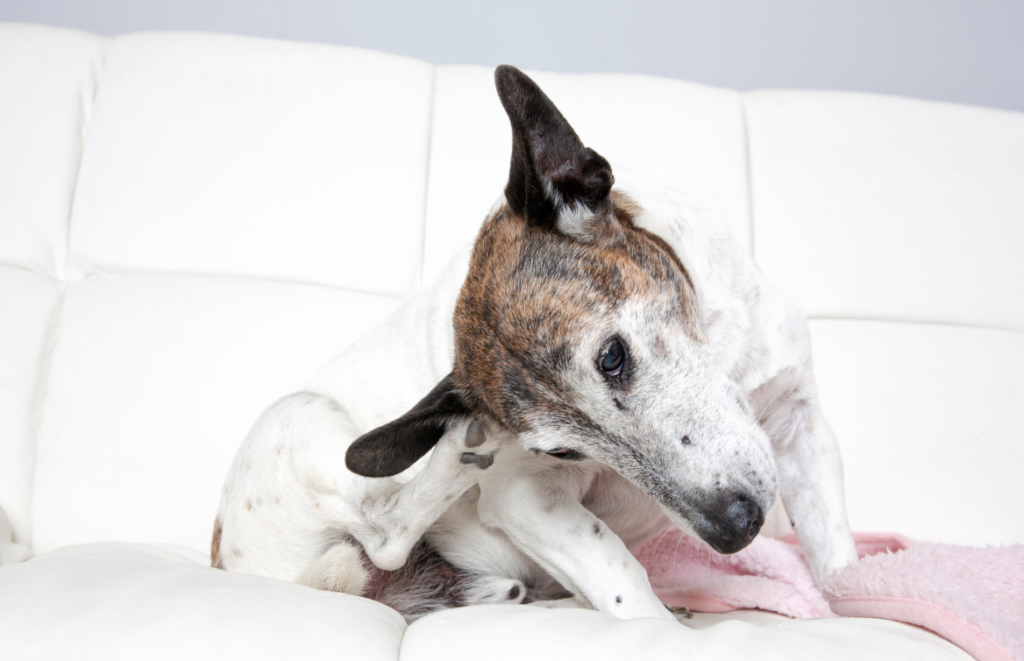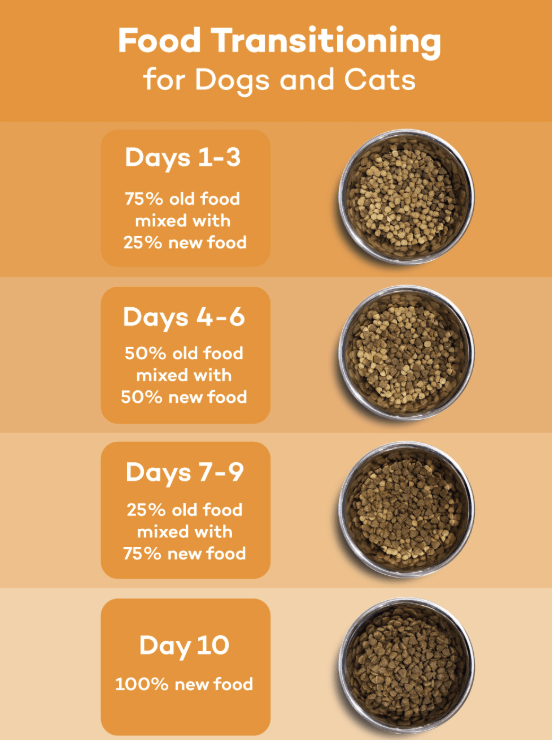As an Amazon Associate, I earn commission from qualifying purchases.
Changing your dog’s diet isn’t as simple as just swapping out one bowl of food for another—it’s a big deal for them! If you’re thinking about switching up your pup’s food, it’s important to make the transition gentle and safe. Maybe the new diet is for health reasons, or you’re ready to upgrade to something fresher and better for them. Whatever the reason, this guide will help you make the switch with care to make the change as easy as possible for your dog.

Understanding Why Your Dog Might Need a New Diet
Before you start switching your dog’s food, it’s important to understand the reason behind the change. There are plenty of reasons you might need (or want) to make the switch. Maybe your vet recommended a hypoallergenic diet to help with skin problems, or your dog is aging and needs a diet tailored to their new nutritional needs. Or perhaps you’re upgrading from a basic kibble to something fresher, like a raw or homemade option. Whatever the reason, knowing the “why” will help you make the best choice for your pup.
The Importance of a Gradual Transition

Dogs have sensitive stomachs, so sudden changes to their diet can lead to discomfort, diarrhea, or even loss of appetite. By taking a gradual and thoughtful approach, you can make the transition smoother for your dog–and for you too!
So, how long does this whole gradual switch take? Usually, about 7 to 10 days does the trick, but it really depends on how well your dog handles the change. By slowly mixing their old food with the new stuff, you give their tummy time to adjust to the new ingredients and help avoid any upset stomach or other digestive issues.
The standard recommendation is to follow this rough schedule:
- Days 1-3: Mix 75% of the old food with 25% of the new food.
- Days 4-6: Mix 50% of the old food with 50% of the new food.
- Days 7-9: Mix 25% of the old food with 75% of the new food.
- Day 10: Feed 100% of the new food.
Keep an eye on your dog’s poop, appetite, and overall vibe during the switch. If you notice loose stools, vomiting, or anything that seems off, slow things down and give your pup a little more time to adjust.
Picking the Perfect New Food for Your Pup
Finding the right food for your dog is all about meeting their unique needs. Maybe your pup could benefit from grain-free options, or need something easy on the stomach. Here’s a quick rundown of popular dog food types and why they might work for your furry friend:
1. Kibble (Dry Food)
Kibble is super convenient and budget-friendly, which makes it a go-to for many dog parents. If you’re looking for a solid option, Blue Buffalo Life Protection Formula, is a fan favorite on Amazon. It’s packed with healthy ingredients, like protein, grains, and veggies, and skips the artificial stuff.
2. Canned (Wet Food)
Got a picky eater or a pup with dental issues? Wet food might be the way to go. It’s soft, packed with moisture, and perfect for dogs that need extra hydration. Hill’s Science Diet Wet Dog Food is a highly rated choice on Amazon among pet parents and provides balanced nutrition in a dog-friendly, easy-to-eat format.
3. Fresh/Frozen Food
Fresh food options like Just Food for Dogs or Ollie are all the rage. They use human-grade ingredients and cater to dogs at any life stage. If you don’t want to commit to a subscription, Freshpet Select Fresh From the Kitchen is a great choice you can grab on Amazon or in grocery stores.
4. Raw Food Diet
Thinking about going raw? While it’s not for everyone, a raw diet can mimic what dogs ate in the wild. For a hassle-free option, check out Stella & Chewy’s Raw Freeze-Dried Dog Food—all the benefits of raw feeding without the mess of handling raw meat. The key is finding something that works for your dog’s specific needs while making mealtime something they’ll love!
Tips for Switching Your Dog’s Diet
Transitioning your dog to a new food? It doesn’t have to be a headache! Here’s a casual, easy-to-follow guide to help you make the change without stressing you—or your pup—out. Wet and fresh foods tend to be more nutrient-dense, so it’s important to measure portions carefully using a cup or scale to make sure your pup isn’t overeating. Depending on what kind of food you’re transitioning to, you may need to adjust your approach.
From Kibble to Wet or Fresh Food
Switching from kibble to wet or fresh food? Your dog will probably be all over it—these foods are tastier and easier to eat. The biggest challenge here? Portion control.
From Wet to Dry Food
If your dog is used to wet food, kibble might not be love at first bite. Try adding warm water or low-sodium broth to soften the kibble and make it more appealing. You can also mix in a little wet food at first to ease the transition.
Adding Supplements
Changing diets is a great time to throw in a little extra support with supplements:
- Probiotics: These can help keep your dog’s tummy happy and avoid digestive issues during the switch. FortiFlora by Purina is a favorite—it’s easy to sprinkle on food and has great reviews from pet parents.
- Omega-3 Fatty Acids: If the new diet doesn’t have fish or other omega-rich ingredients, supplements like Zesty Paws Omega Bites can help keep your dog’s skin and coat shiny and healthy. Bonus: They’re soft chews most dogs gobble right up.
What to Do if Things Don’t Go Smoothly
Even if you follow all the tips, hiccups can happen. Here’s how to handle common issues:
1. Refusal to Eat the New Food
If your dog’s being a bit stubborn, try jazzing up the meal with a topper. A splash of low-sodium chicken broth, some plain boiled chicken, or even a spoonful of canned pumpkin can make the new food more tempting. Be patient—it might take a little time for them to come around.
2. Upset Stomach
Tummy troubles like diarrhea or vomiting? Slow things down. Cut back on how much of the new food you’re mixing in and give your dog extra time to adjust. Adding a little plain canned pumpkin (just make sure it’s not pumpkin pie mix!) can also help soothe their digestion.
3. Weight Changes
Switching foods can impact your dog’s weight, so keep an eye on it. You should be able to feel their ribs but not see them, and they should have a visible waistline. If you notice weight gain or loss, adjust portion sizes as needed.
4. Allergic Reactions
If your pup starts itching, losing hair, or showing other signs of allergies, the new food might not agree with them. Talk to your vet—they can help figure out the issue and might suggest trying a novel protein diet (like duck or venison) to identify the problem.
Keeping Tabs on Your Dog’s Health
As your dog transitions to their new food, watch for these signs to know things are going well:
- Poop check: Firm, normal stools are a great sign of healthy digestion.
- Shiny Coat, Healthy Skin: Their fur should stay glossy, and their skin should be itch-free.
- Energy Levels: If they’re still playful and active, you’re on the right track.
- Good appetite: A happy eater is a healthy eater!
When to Call the Vet
Your vet is your best ally during a diet switch, especially if your dog has health conditions like allergies, diabetes, or kidney issues. If you notice anything unusual or aren’t sure what food is best, don’t hesitate to reach out. They might even recommend a special therapeutic diet if your pup needs it.
Stay Chill and Flexible
Patience is key! Some dogs adapt quickly, while others need a little more time. Keep mealtimes positive and stress-free—it’ll make a big difference for your pup. Also, try to avoid frequent food changes once you’ve found something that works. Too many changes can turn your dog into a picky eater or cause ongoing tummy troubles.
Final Thoughts
Switching your dog’s diet doesn’t have to be overwhelming. With a gradual transition, the right food for their needs, and a little extra care, you’ll set your pup up for success. Don’t forget to use helpful tools like probiotics or omega supplements to make the process even smoother.
At the end of the day, it’s all about finding what works best for your furry friend. With a little patience and love, you’ll have them thriving on their new diet in no time.
Happy feeding—here’s to making mealtimes fun and stress-free for you and your dog!
